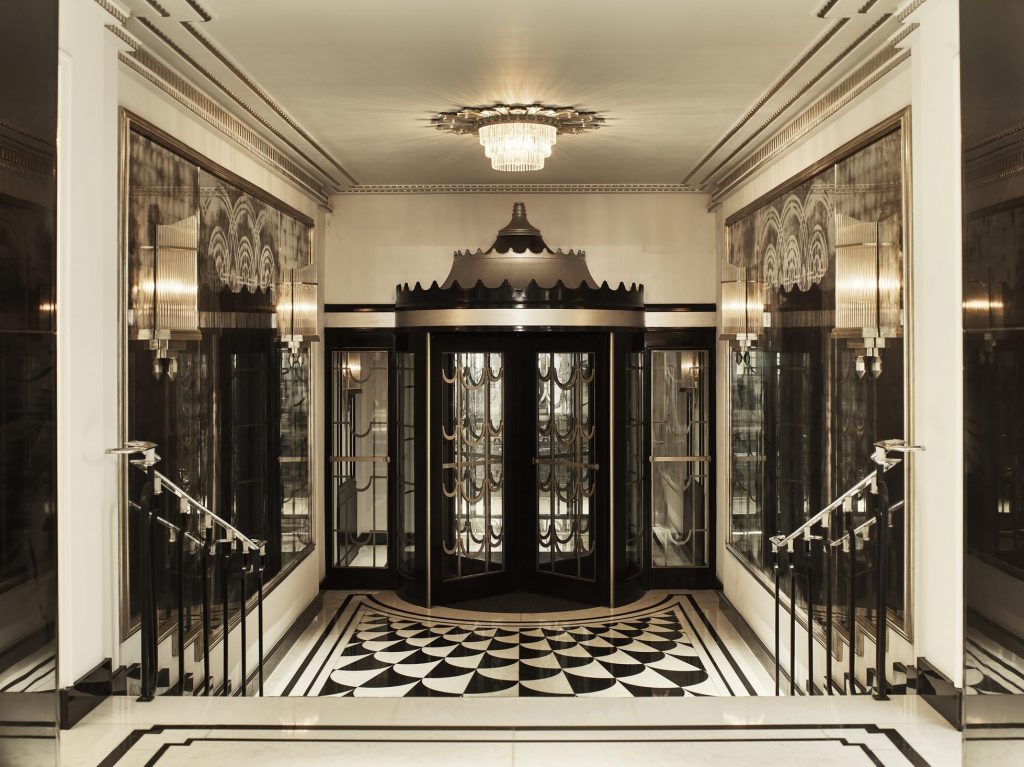A hundred years ago, a London hotel announced to the press that it was to undertake some renovations. They would be, it promised ‘nothing to startle but much to admire’. Instead, the result is one of the most important hotel interiors of the Art Deco period.
‘Art Deco sought to fuse art and industrial design, initially at an exhibition held in 1925 in Paris, the Exposition Internationale des Arts Décoratifs et Industriels Modernes in the Grand Palais,’ Kate Hudson tells me.
While hotels – especially luxury ones – need armies of employees, only a very few have their own archivist. Kate Hudson is employed by Claridge’s in Mayfair. For guests and design enthusiasts who want more than surface appreciation, Hudson runs regular tours, which are free to attend.
In 1926, Basil Ionides was commissioned to transform the restaurant and several suites in the original Claridge’s building. Ionides – who grew up in Scotland and attended the highly influential Glasgow School of Art – published two best-selling books, Colour and Interior Decoration (1926) and Colour in Everyday Rooms (1934). His influence can particularly be seen in Claridge’s restaurant – glass windows with starburst designs in coloured glass, pillars and cornicing.
Soon afterwards, Oswald Milne started to transform large swathes of the Claridge’s 1898 building, followed by an extension that included a ballroom and another wing of rooms but it’s his entrance to the hotel that is now considered to be one of London’s most important pieces of Art Deco architecture. This light-filled glass and steel construction with curves in all the right places leads into the hotel’s lobby and foyer. A century later, seemingly untouched with Milne’s original mirrors and pillars, this is still Claridge’s hub.
Living History At Its Most Elevated
In the latter part of the 20th century, many hotels weren’t particularly respectful of the period. The Savoy-Plaza in New York and the Palais Rose in Paris both fell victim to the wrecking ball, but many other hotels saw once-prized Art Deco detailing banished in refurbishments.
However, the interiors produced by Ionides and Milne are still in situ at Claridge’s, from the whimsical tent over the entrance to metal etchings around doorways. Above the entrance to The Fumoir is a glass panel that was presented to the hotel by Rene Lalique in 1931. By the grand piano (and Claridge’s is the sort of hotel that will have a grand piano in its entrance), is a small, very delightful sculpture by Jacques Adnet of a dove. Marion Dorn, a pioneering textile designer, was commissioned to produce rugs. Her original designs – with her trademark geometric patterns – are regularly rewoven so that they can remain in place,
While the Savoy remains London’s most famous Art Deco hotel (and also has its own archivist, Susan Scott), at Claridge’s, the design ethos fused with the rise of the Bright Young Things, a movement that emerged after the First World War but also, immediately in its aftermath, Spanish flu, a pandemic that had to an exceptionally high death toll among the young.
Bright Young Things, Then and Now
Largely from aristocratic backgrounds, the Bright Young Things decided to party, and Claridge’s was one of their most popular destinations. Key participants Stephen Tennant and Cecil Beaton created elaborate fancy dress for parties at the hotel. (Between October 9 and 11 January 2026, the exhibition, Cecil Beaton’s Fashionable World, taking place at the National Portrait Gallery, will explore his work as a photographer, including this period) but the artistic outpouring was literary too; F Scott Fitzgerald stayed at Claridge’s. Nancy Mitford, who chronicled the movement in novels that included Love in a Cold Climate would have been a regular too.
‘There is a tendency to mythologise the fashion and that sense of immediacy of the era, but Claridge’s was undoubtedly the backdrop to some wonderful revelries,’ points out Hudson as we look at a case of Claridge’s dance cards and party invitations from the era.
Then, as now, a good hotel always gives guests what they want. Throughout the anniversary, Claridge’s is hosting talks on the history and design of Art Deco as well as the tours. Today’s Art Deco fans are also able to have a Claridge’s Bright Young Things sleepover, which includes a stay in one of the hotel’s original Art Deco suites, cocktails in The Fumoir – including those invented in the 1920s by Beaton.

